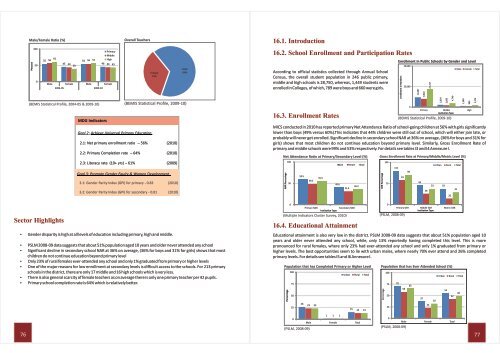Gwadar - Government of Balochistan
Gwadar - Government of Balochistan
Gwadar - Government of Balochistan
Create successful ePaper yourself
Turn your PDF publications into a flip-book with our unique Google optimized e-Paper software.
Male/Female Ratio (%)<br />
Percent<br />
100<br />
50<br />
0<br />
55<br />
56<br />
61<br />
45<br />
(BEMIS Statistical Pr<strong>of</strong>ile, 2004-05 & 2009-10)<br />
Sector Highlights<br />
44<br />
39<br />
Male Female Male Female<br />
54<br />
56<br />
57<br />
2004-05 2009-10<br />
46<br />
MDG Indicators<br />
Primary<br />
Middle<br />
High<br />
44<br />
43<br />
Overall Teachers<br />
Goal 2: Achieve Universal Primary Education<br />
Female<br />
34%<br />
Male<br />
66%<br />
(BEMIS Statistical Pr<strong>of</strong>ile, 2009-10)<br />
2.1: Net primary enrollment ratio – 56% (2010)<br />
2.2: Primary Completion rate – 64% (2010)<br />
2.3: Literacy rate (10+ yrs) – 61% (2009)<br />
Goal 3: Promote Gender Equity & Women Development<br />
3.1: Gender Parity Index (GPI) for primary - 0.83 (2010)<br />
3.2: Gender Parity Index (GPI) for secondary - 0.81 (2010)<br />
Ÿ Gender disparity is high at all levels <strong>of</strong> education including primary, high and middle.<br />
Ÿ PSLM 2008-09 data suggests that about 51% population aged 10 years and older never attended any school<br />
Ÿ Significant decline in secondary school NAR at 36% on average, (36% for boys and 31% for girls) shows that most<br />
children do not continue education beyond primary level<br />
Ÿ Only 23% <strong>of</strong> rural females ever-attended any school and only 1% graduated from primary or higher levels<br />
Ÿ One <strong>of</strong> the major reasons for low enrollment at secondary levels is difficult access to the schools. For 213 primary<br />
schools in the district, there are only 17 middle and 16 high schools which is very less.<br />
Ÿ There is also general scarcity <strong>of</strong> female teachers as on average there is only one primary teacher per 42 pupils.<br />
Ÿ Primary school completion rate is 64% which is relatively better.<br />
16.1. Introduction<br />
16.2. School Enrollment and Participation Rates<br />
According to <strong>of</strong>ficial statistics collected through Annual School<br />
Census, the overall student population in 246 public primary,<br />
middle and high schools is 28,750, whereas, 1,449 students were<br />
enrolled in Colleges, <strong>of</strong> which, 789 were boys and 660 were girls.<br />
16.3. Enrollment Rates<br />
MICS conducted in 2010 has reported primary Net Attendance Ratio <strong>of</strong> school-going children at 56% with girls significantly<br />
lower than boys (49% versus 60%).This indicates that 44% children were still out <strong>of</strong> school, which will either join late, or<br />
probably will never get enrolled. Significant decline in secondary school NAR at 36% on average, (36% for boys and 31% for<br />
girls) shows that most children do not continue education beyond primary level. Similarly, Gross Enrollment Rate <strong>of</strong><br />
primary and middle schools were 99% and 53% respectively. For details see tables I3 and I4 Annexure I.<br />
Net Attendance Ratio at Primary/Secondary Level (%)<br />
16.4. Educational Attainment<br />
Enrollment in Public Schools by Gender and Level<br />
(BEMIS Statistical Pr<strong>of</strong>ile, 2009-10)<br />
76 77<br />
NAR Percentage<br />
Enrollment in Numbers<br />
50,000<br />
25,000<br />
0<br />
11,807<br />
9,920<br />
21,727<br />
2,654<br />
2,095<br />
4,749<br />
Male Female Total<br />
1,289<br />
985<br />
Primary Middle<br />
Institution Type<br />
High<br />
Educational attainment is also very low in the district. PSLM 2008-09 data suggests that about 51% population aged 10<br />
years and older never attended any school, while, only 13% reportedly having completed this level. This is more<br />
pronounced for rural females, where only 23% had ever-attended any school and only 1% graduated from primary or<br />
higher levels. The best opportunities seem to lie with urban males, where nearly 70% ever attend and 26% completed<br />
primary levels. For details see tables I5 and I6 Annexure I.<br />
Population that has Completed Primary or Higher Level<br />
Percentage<br />
100<br />
50<br />
0<br />
100<br />
75<br />
50<br />
25<br />
0<br />
59.5<br />
26<br />
23<br />
(PSLM, 2008-09)<br />
49.2<br />
23<br />
55.5<br />
1<br />
1<br />
40.6<br />
Male Female Total<br />
1<br />
31.4<br />
Primary NAR Secondary NAR<br />
Institution Type<br />
(Multiple Indicators Cluster Survey, 2010)<br />
Male Female Total<br />
Urban Rural Total<br />
15<br />
36.2<br />
13<br />
13<br />
Gross Enrollment Rate at Primary/Middle/Metric Level (%)<br />
GER Percentage<br />
Population that has Ever Attended School (%)<br />
Percentage<br />
140<br />
70<br />
0<br />
(PSLM, 2008-09)<br />
100<br />
75<br />
50<br />
25<br />
0<br />
112<br />
70<br />
81<br />
58<br />
(PSLM, 2008-09)<br />
99<br />
65<br />
64<br />
37<br />
36<br />
Primary GER Middle GER<br />
Institution Type<br />
Matric GER<br />
23<br />
Male Female Total<br />
53<br />
32<br />
Urban Rural Total<br />
53<br />
Urban Rural Total<br />
55<br />
20<br />
42<br />
41<br />
49<br />
2,274


